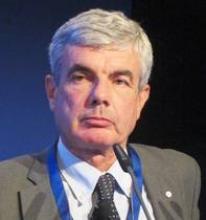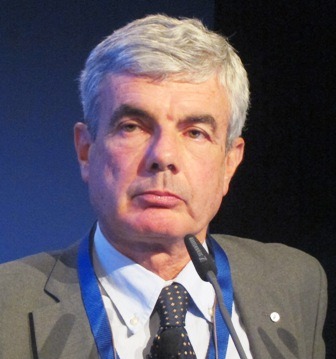User login
BERLIN – Older patients with type 2 diabetes are very likely to have left ventricular dysfunction, even in the absence of any sign of cardiac disease.
However, at least some of this dysfunction can remit over time, perhaps as a result of effective diabetes treatment, Dr. Carlo Bruno Giorda said at the annual meeting of the European Association for the Study of Diabetes.
Dr. Giorda reported results of Left Ventricular Dysfunction in Diabetes (DYDA), a 2-year prospective study that tracked the development of left ventricular dysfunction in 957 patients with type 2 diabetes who did not have any signs of cardiac disease at baseline.
DYDA’s secondary end point was a combination of all-cause mortality and cardiovascular hospitalization; the study also sought to identify factors predicting these outcomes, said Dr. Giorda of the Ospedale Maggiore, Chieri, Italy.
The study defined left ventricular systolic dysfunction as an ejection fraction of less than 50% and/or a midwall fractional shortening of 15% or less. At baseline, all patients underwent an echocardiogram to determine left ventricular dysfunction. Imaging revealed that 60% of the cohort had some form of LVD – systolic (21%), diastolic (27%), or both (12%).
The patients were a mean of 61 years; 62% were men. Almost half (44%) were overweight and 35% were obese. The median heart rate was 72 beats per minute. The median blood pressure was 137/80.
Diabetes medications included sulfonylureas (43%), insulin (32%), repaglinide (11%), metformin (66%), acarbose (2%), and glitazones (5%). Most patients (60%) were hypertensive and being treated for that; 55% were taking medication for dyslipidemia.
Comorbidities included vascular disease (8%), diabetic retinopathy (13%), diabetic neuropathy (8%), and thyroid disease (8%). Others were chronic obstructive pulmonary disease (3%) and chronic kidney disease (2%).
Diabetes was well-controlled in the group, Dr. Giorda said. The median hemoglobin A1c was 6.7%, and the median blood glucose 142 mg/dL. The median creatinine level was 0.90 mg/dL, and the median glomerular filtration rate, 84 mL/min.
By the 2-year mark, 15 patients had died; only 3 of these deaths were attributed to cardiovascular causes. Eleven patients had died of non-cardiovascular issues, and one death occurred of unknown etiology. There had been 181 hospitalizations among 139 patients. The majority of these (133) were for non–cardiovascular problems.
Dr. Giorda said the association with repaglinide was probably a chance finding. "We even controlled for renal insufficiency, since repaglinide is often used for those patients in Italy, and this relationship still emerged."
At the end of the study period, new onset systolic dysfunction had developed in 17% and diastolic in 22% of the initially negative group.
A multivariate analysis identified several baseline factors that significantly predicted the development of LVD, including age (67 years vs. 56 years), HbA1c (7.6% vs. 6%), and heart rate (90 vs. 68 beats per minute.
A surprise finding, however, was that LVD remitted in several patients, Dr. Giorda said. "There was reversal of LVD in 12% of the patients who had it at baseline. We can’t say why it reversed ... maybe it was due to [diabetes treatment]. But we can say that in some patients, LVD can be considered temporary."
Dr. Giorda had no financial disclosures.
BERLIN – Older patients with type 2 diabetes are very likely to have left ventricular dysfunction, even in the absence of any sign of cardiac disease.
However, at least some of this dysfunction can remit over time, perhaps as a result of effective diabetes treatment, Dr. Carlo Bruno Giorda said at the annual meeting of the European Association for the Study of Diabetes.
Dr. Giorda reported results of Left Ventricular Dysfunction in Diabetes (DYDA), a 2-year prospective study that tracked the development of left ventricular dysfunction in 957 patients with type 2 diabetes who did not have any signs of cardiac disease at baseline.
DYDA’s secondary end point was a combination of all-cause mortality and cardiovascular hospitalization; the study also sought to identify factors predicting these outcomes, said Dr. Giorda of the Ospedale Maggiore, Chieri, Italy.
The study defined left ventricular systolic dysfunction as an ejection fraction of less than 50% and/or a midwall fractional shortening of 15% or less. At baseline, all patients underwent an echocardiogram to determine left ventricular dysfunction. Imaging revealed that 60% of the cohort had some form of LVD – systolic (21%), diastolic (27%), or both (12%).
The patients were a mean of 61 years; 62% were men. Almost half (44%) were overweight and 35% were obese. The median heart rate was 72 beats per minute. The median blood pressure was 137/80.
Diabetes medications included sulfonylureas (43%), insulin (32%), repaglinide (11%), metformin (66%), acarbose (2%), and glitazones (5%). Most patients (60%) were hypertensive and being treated for that; 55% were taking medication for dyslipidemia.
Comorbidities included vascular disease (8%), diabetic retinopathy (13%), diabetic neuropathy (8%), and thyroid disease (8%). Others were chronic obstructive pulmonary disease (3%) and chronic kidney disease (2%).
Diabetes was well-controlled in the group, Dr. Giorda said. The median hemoglobin A1c was 6.7%, and the median blood glucose 142 mg/dL. The median creatinine level was 0.90 mg/dL, and the median glomerular filtration rate, 84 mL/min.
By the 2-year mark, 15 patients had died; only 3 of these deaths were attributed to cardiovascular causes. Eleven patients had died of non-cardiovascular issues, and one death occurred of unknown etiology. There had been 181 hospitalizations among 139 patients. The majority of these (133) were for non–cardiovascular problems.
Dr. Giorda said the association with repaglinide was probably a chance finding. "We even controlled for renal insufficiency, since repaglinide is often used for those patients in Italy, and this relationship still emerged."
At the end of the study period, new onset systolic dysfunction had developed in 17% and diastolic in 22% of the initially negative group.
A multivariate analysis identified several baseline factors that significantly predicted the development of LVD, including age (67 years vs. 56 years), HbA1c (7.6% vs. 6%), and heart rate (90 vs. 68 beats per minute.
A surprise finding, however, was that LVD remitted in several patients, Dr. Giorda said. "There was reversal of LVD in 12% of the patients who had it at baseline. We can’t say why it reversed ... maybe it was due to [diabetes treatment]. But we can say that in some patients, LVD can be considered temporary."
Dr. Giorda had no financial disclosures.
BERLIN – Older patients with type 2 diabetes are very likely to have left ventricular dysfunction, even in the absence of any sign of cardiac disease.
However, at least some of this dysfunction can remit over time, perhaps as a result of effective diabetes treatment, Dr. Carlo Bruno Giorda said at the annual meeting of the European Association for the Study of Diabetes.
Dr. Giorda reported results of Left Ventricular Dysfunction in Diabetes (DYDA), a 2-year prospective study that tracked the development of left ventricular dysfunction in 957 patients with type 2 diabetes who did not have any signs of cardiac disease at baseline.
DYDA’s secondary end point was a combination of all-cause mortality and cardiovascular hospitalization; the study also sought to identify factors predicting these outcomes, said Dr. Giorda of the Ospedale Maggiore, Chieri, Italy.
The study defined left ventricular systolic dysfunction as an ejection fraction of less than 50% and/or a midwall fractional shortening of 15% or less. At baseline, all patients underwent an echocardiogram to determine left ventricular dysfunction. Imaging revealed that 60% of the cohort had some form of LVD – systolic (21%), diastolic (27%), or both (12%).
The patients were a mean of 61 years; 62% were men. Almost half (44%) were overweight and 35% were obese. The median heart rate was 72 beats per minute. The median blood pressure was 137/80.
Diabetes medications included sulfonylureas (43%), insulin (32%), repaglinide (11%), metformin (66%), acarbose (2%), and glitazones (5%). Most patients (60%) were hypertensive and being treated for that; 55% were taking medication for dyslipidemia.
Comorbidities included vascular disease (8%), diabetic retinopathy (13%), diabetic neuropathy (8%), and thyroid disease (8%). Others were chronic obstructive pulmonary disease (3%) and chronic kidney disease (2%).
Diabetes was well-controlled in the group, Dr. Giorda said. The median hemoglobin A1c was 6.7%, and the median blood glucose 142 mg/dL. The median creatinine level was 0.90 mg/dL, and the median glomerular filtration rate, 84 mL/min.
By the 2-year mark, 15 patients had died; only 3 of these deaths were attributed to cardiovascular causes. Eleven patients had died of non-cardiovascular issues, and one death occurred of unknown etiology. There had been 181 hospitalizations among 139 patients. The majority of these (133) were for non–cardiovascular problems.
Dr. Giorda said the association with repaglinide was probably a chance finding. "We even controlled for renal insufficiency, since repaglinide is often used for those patients in Italy, and this relationship still emerged."
At the end of the study period, new onset systolic dysfunction had developed in 17% and diastolic in 22% of the initially negative group.
A multivariate analysis identified several baseline factors that significantly predicted the development of LVD, including age (67 years vs. 56 years), HbA1c (7.6% vs. 6%), and heart rate (90 vs. 68 beats per minute.
A surprise finding, however, was that LVD remitted in several patients, Dr. Giorda said. "There was reversal of LVD in 12% of the patients who had it at baseline. We can’t say why it reversed ... maybe it was due to [diabetes treatment]. But we can say that in some patients, LVD can be considered temporary."
Dr. Giorda had no financial disclosures.
AT THE ANNUAL MEETING OF THE EUROPEAN ASSOCIATION FOR THE STUDY OF DIABETES
Major Finding: Left ventricular dysfunction was present in 60% of patients with type 2 diabetes, despite the absence of any clinical signs of cardiac problems. However, over 2 years, 12% of the LVD resolved.
Data Source: Left Ventricular Dysfunction in Diabetes (DYDA) was a 2-year prospective study that tracked the development of left ventricular dysfunction in 957 patients with type 2 diabetes who did not have any signs of cardiac disease at baseline.
Disclosures: Dr. Giorda did not have any financial disclosures.

